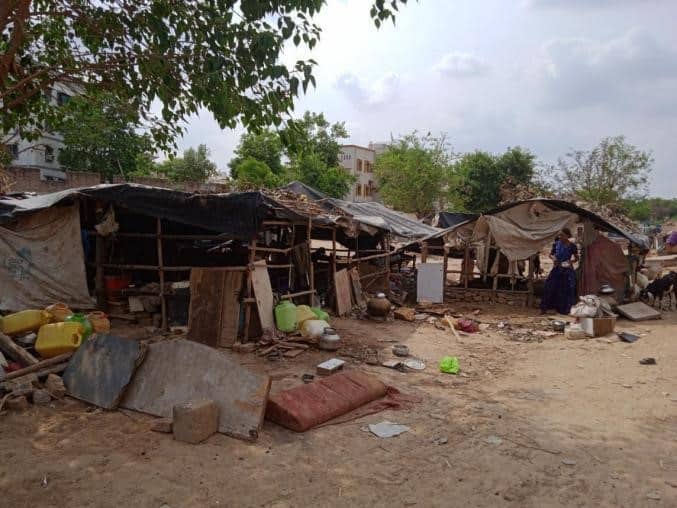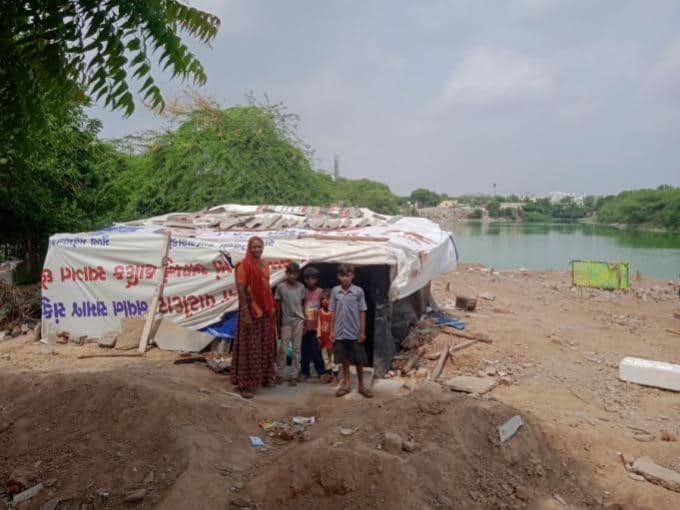In recent months, bulldozers have become symbolic of what German Sociologist Weber describes as the state having the monopoly over legitimate use of force. Whether to punish law breakers by demolishing their homes or to evict people from what are termed illegal encroachments and unauthorised slums in cities, the state is using bulldozers more often than it ever has in the past.
While some bulldozing drives in states like UP and MP happened after communal tension in some areas, bulldozing is also being used in the name of urban renewal.
For instance, in Ahmedabad, three slum sites in the city — Shakri talav in Sarkhej, Ropda talav in Vejalpur and Umiyanagar in Vadaj — were bulldozed in May-June. The official justification is clearing “illegal encroachment” as the land comes under the municipal corporation’s “public reserved land”.
All three slums, where the bulldozers arrived without proper notice, were kaccha jhupdas, with a few semi pakka homes with common concrete wall to install electricity meters. The bulldozer left a total of 271 families homeless.
Settlement history
In Umiyanagar, residents claim they have been living there for 25 years. A lot of them don’t have any residential or identity proofs like Aadhaar, voting card, or ration card. The few residents who do have an Aadhaar card have their names in the voter’s list and claim to have voted in the last two elections
The 120 families living there belong to SC, ST and Denotified castes such as Nat, Bajania, Dantani, Verwa, Rawal, Valmiki and Vanjara, among others. They earn their living from construction work, housekeeping work in residential societies, selling fruits and vegetables, driving cycle rickshaws, collecting and selling fallen hair, hawking and selling toys and balloons at crossroads.
Similarly, Ropda talav housed communities such as Valmikis, Adivasis and Devipujaks who say they have been living there since 2012. The 100 families there do the same kind of casual work as do the people in Shakri Talav, the third slum to be demolished.
But the Shakri talav communities claim it is their third generation presently living there. Their grandfathers were earlier living in the old Fatehwadi area, and after the floods in the 70s, they all moved to the new Fatehwadi area (where the Shakri talav basti is presently existing). The 51 households at the Shakri talav jhupadpati are also from Devipujak and Vanjara communities.
All these families, involved in either street vending, self-employed or casual work, earn between Rs 6000 and Rs 8000 a month.
Read more: Women lead the movement to make Ahmedabad slums climate resilient
For many residents of these bastis, this is not the first time they have faced eviction drives. “Earlier too they used to come,” said Bhavnaben from Umiyanagar. “There are (railway) quarters nearby. Someone would come and tell us whenever some officer was coming to check the site. We would simply close the tent, so that it seems that no structure has been erected. We would open the tents and continue as usual after the officer leaves. But it has become a lot more cruel and inhumane now. They would not listen to anyone or anything while demolising our homes.”
Petitions to stay the demolition at Shakri talav and Umiyanagar, petitions are pending before courts. The basti residents have also been trying to acquire ID documents for those previously undocumented. They have written letters and petitions to the city collector, the mamlatdar who has the authority over gamtals i.e urban villages, which do not come under corporation land, to the commissioner’s office, even the chief minister.
And yet the bulldozers arrived and crushed their chappras despite verbal assurance from the authorities that without alternative housing arrangement, people would not be evicted.
Rehabilitation promises
In the case of Ropda talav, after repeated pleas and letters to the administration, they were given a verbal assurance by Ahmedabad municipal corporation’s Standing Committee Chairman that flats in government schemes will be provided. On the basis of this assurance, the residents and the civil society organisation Rehthan Adhikar Manch, led by Ms. Bina Jadav which is fighting for the alternative housing of Ropda talav slum residents, have decided not to seek legal remedy.
But these assurances seem embroiled in confusion. One government official asked residents to submit residential proofs such as Aadhaar and voter IDs under the “cut-off eligibility criteria”, but issued only before December 31 2010, if the residents want to claim the government housing schemes. A near impossible task for the largely illiterate slum population of Ropda talav.
The Ropda talav basti residents feel this is another effort by the administration to mislead them. Even though schemes such as Central government’s PMAY and State government’s MMGY, does not specify any “cut-off” eligibility criteria for application for government housing, residents feel confused about authorities asking them to submit these.
Force and threats
Residents at all these three sites say that this time, the demolition officers violated all due processes, procedures and orders passed by the courts and the assurances that the city authorities gave. Besides, when the bulldozers came, the officials did not even give time for residents to collect the belongings. With heavy deployment of police, women and children were heckled, accompanied by threats of further demolitions if the tents were again erected.
In Shakri talav, one woman recounted how she was grabbed by her hair, dragged from her home to the police vehicle and locked inside for hours, while the officers demolished their homes. “I had to face humiliation in front of everyone just because I was trying to protect my chappra,” the woman said. “When my son came to protect me, he got a beating”.
“Officers do not care even if there is a pregnant women expecting childbirth, or if there is sickness or death in the family,” said Bhavnaben of Umiyanagar. “The government is so insensitive towards the poor that they not come to see even once (after demolition) to see how we are living,” said Santoshbhai of Ropda talav. “We are living in the open now because they have threatened us not to erect chappras again”.
Officials present at the demolition scene defended their actions saying they are only following orders.
Residents in all three bastis said it was easier for them to get stay orders from the courts earlier, with the help of civil society activists and lawyers. They had the support of several well-intentioned people within the government also. But no one paid them any heed this time around.
Read more: Where goes the slum dweller evicted in Indian cities?
Not being able to even clear the debris from their homes, residents of all three bastis have not been able to go back to work as they fear the authorities could come again any time again, and force them to leave the site. So they have to sleep in the open, cook in the open and use their mobile phone’s flashlight in the dark.
Price of drinking water cans have gone up which these people can barely afford. With no income, all families are finding it difficult to make ends meet. With the biggest burden inevitably falling on the most vulnerable among them — women, children, and elderly people.
All the residents in the three slum sites say it is not the demolitions that they are against, but the non-provisioning of an alternative shelter. A recent study on PMAY’s implementation in Gujarat reveals that the state has failed in providing housing to the urban poor under the much advertised Central government scheme, despite there being a “significant demand” in 83 out of 153 Gujarat municipalities that the study covered.
Court verdicts ignored
The demolitions have violated the many “alternative shelter” provisions that both the executive and judiciary have guaranteed to the urban poor. The 2010 Delhi HC order in Sudama Singh & others vs Government of Delhi (2010), mentions “the State’s constitutional and statutory obligation to ensure” that rehabilitation “has to be a meaningful exercise consistent with the rights to life, livelihood and dignity” of the affected people.
The 2020 Gujarat HC judgement in Vora Zakirhusain Valibhai vs State of Gujarat (2020), minces no words in underlining this principle when it observed: “The weaker sections of the society have the basic human and constitutional right to shelter and it becomes the paramount duty of the State to fulfill those”.
At the same time, it needs to be stated that these verdicts do not give anyone the right to encroach and erect structures on footpaths, pavements or public space or at a place reserved or earmarked for a public utility.
While the Delhi HC asserted that the right to shelter is an unconditional right and that it is the state’s basic duty to provide such shelter, another HC ruling says that if the urban poor, without the state’s support of alternative shelter provisioning or rehabilitation, erects structures for their own and their family’s protection on public space, it would still be deemed as encroachment.
The bulldozer, it seems, has now become a symbol of the clash between the judiciary’s affirmation that alternative housing and rehabilitation should precede any slum demolition and the executive’s view that urban poor building shelters on public land is encroachment. And should be removed. By brute force, if needed.
(The author would like to thank Bina Jadav from Rehthan Adhikar Manch, Anil Macwan and Lalit Parmar from St. Xavier’s Social Service Society, for their help in explaining the context of the demolition drives and facilitating field visits to these sites)

